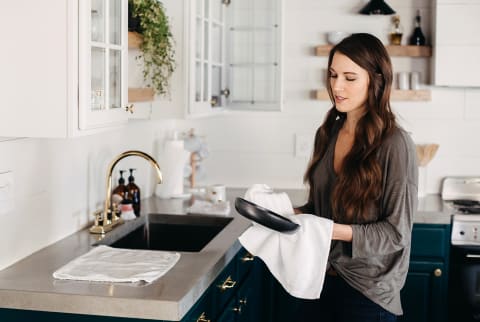Advertisement
The Best (& Worst) Cookware Materials For Minimizing Environmental Chemical Exposure


In the well-being space, we spend a lot of time (and money) prioritizing healthy, nourishing foods, often striving for the highest quality we can afford. We read product labels, load up on antioxidant-rich foods, and often seek out organically grown and raised produce and animal products. But what about the materials that we cook that food in?
Thanks to flashy, modern marketing campaigns; contemporary, eye-pleasing color palates; and celebrity endorsements, I've found that buying cookware is more about what's hip than what's healthy (or sustainable).
As an environmental health expert and science communicator with over a decade of experience in educating health professionals about toxicant exposure and potential health effects, one of the most frequently asked questions is "What kind of cookware should I use?"
Why cookware matters
First, I'll say this: We are exposed to hundreds of toxic chemicals every day, and we've only really ramped up research into what this might mean in the last 15 to 20 years. While we cannot avoid exposure to all toxic chemicals, research does show that we can reduce exposure by changing the foods we eat1, the products we buy2, and our behaviors3.
When it comes to toxic chemical exposure, the goal is not to strive for 100% nontoxic everything, as this is technically impossible (even polar bears in the Arctic4 have toxic chemicals in their bodies!). What we're aiming for is to reduce our exposure in ways that are accessible, while not stressing out about the exposures we can't reduce.
Unfortunately, some popular types of cookware expose us to harmful chemicals every time we use them. Will cooking on one of these types of materials automatically mean you'll get sick or develop some serious health issue? No, but using materials with harmful chemicals every day, even multiple times a day, can add up over time and lead to increased risk of certain health conditions or exacerbate conditions that already exist.
Given that cookware is something we use every day, it's an opportunity to minimize exposure to toxic chemicals like PFAS, and heavy metals like lead and arsenic.
Toxic chemicals hiding in cookware
Consumer goods regulations in the U.S. and in most countries around the world don't require manufacturers to disclose information about what materials and chemicals they use. This leaves consumers a little bit (or sometimes entirely) in the dark. Cookware is no exception.
While many types of cookware can be a source of exposure to harmful chemicals, the most concerning is nonstick cookware due to the use of per- and polyfluoroalkyl substances, aka PFAS chemicals.
You've likely read about PFAS chemicals‚ they're in drinking water, carpeting5, fast food packaging, house dust6, and they're in us; PFAS compounds have been measured in the blood7 of nearly all Americans.
PFAS is an enormous class of between 4,000 and 12,000 human-made chemicals, most of which we don't know anything about. The two most heavily studied chemicals in this class, PFOA and PFOS, were used for decades to make, among other things, nonstick-coated cookware.
While most uses of PFOA and PFOS were voluntarily phased out of use in the early 2000s due to their toxicity and persistence, they were replaced with similarly toxic but slightly less persistent versions. In other words, despite the marketing language you'll often see from cookware manufacturers, claims of "PFOA-free" or "PFOS-free" are meaningless, as the newer versions aren't safer. This swapping of one toxic chemical for another is referred to as a "regrettable substitution."
To date, PFAS exposure has been linked to:
- Fertility issues8 and pregnancy-induced hypertension/preeclampsia
- Increased cholesterol9
- Changes in the immune system10
- Increased risk of certain cancers11 (e.g., testicular and kidney cancer)
- Changes in fetal and child development12
- Decreased vaccine response in children13
- Liver damage14
- Increased risk of thyroid disease15
- Increased risk of asthma16
While our primary exposure to PFAS comes from drinking water, eating food contaminated with PFAS, interacting with furniture treated with it, and from house dust, new research may move cookware further up the list.
A study published in late 2022 in the Science of the Total Environment found that a single scratch on a nonstick-coated pan can release thousands to over 2,300,000 microplastic and nanoplastic PFAS particles17.
When heated to over 500 degrees Fahrenheit, PFAS-based coatings begin to break down and can release toxic PFAS gases. While manufacturers claim this happens only at temperatures well above normal cooking temperatures, when Good Housekeeping put those claims to the test, they found that a lightweight pan reached 507 degrees after just 1 minute and 45 seconds, and that temps rose to 577 degrees Fahrenheit after cooking hamburgers for 8.5 minutes in a heavyweight pan.
Clearly, pans can reach these dangerous temperates far quicker than companies claim, potentially exposing people daily to toxic PFAS fumes.
We cannot avoid all sources of PFAS, but replacing the cookware and bakeware in your home that is nonstick coated is one action you can take.
Cookware that I avoid
The following types of cookware all have toxicity issues that place them in the "avoid whenever possible" category for me:
Nonstick coated cookware
For all of the reasons detailed above, I think it's time we phase out all nonstick-coated cookware in our kitchens. None of us need an additional and avoidable exposure to these chemicals.
Ceramic-coated cookware
Ceramic-coated cookware has quickly become one of the most popular types on the market, and many companies claim their ceramic pans are nontoxic.
But contrary to their name, the coatings on these pans are not actually ceramic—they just look like ceramic. These pans do have a nonstick surface that is achieved by the use of silicon-based coatings rather than PFAS coatings. Although we don't have enough good research to confidently state that these are safe, the bigger issue with ceramic-coated cookware is that they are wasteful.
Even when cared for according to the manufacturer's instructions, these coatings tend to only last one to two years at most, with many customers complaining that the nonstick coating wore off after only six months. This means you'll be buying new cookware every year, which is a waste of money and resources.
Unglazed cookware
Clay pots can be beautiful. They've been used for thousands of years, and are still a staple in millions of kitchens around the world. Unglazed clay pots are inexpensive and popular, but depending on the composition of the clay, it may leach metals18 like lead, cadmium, and arsenic19, which are all highly toxic.
It's impossible to know whether these metals are present in any given cookware item without testing, which can be prohibitively expensive, so I generally recommend people avoid using these to cook or serve food.
Glazed cookware
Many types of clay cookware are glazed with decorative, colorful designs. While beautiful, the glazes often contain heavy metals18 like lead, cadmium, arsenic, and more and have been shown to leach into foods prepared or served in them.
- Handmade with a crude appearance or irregular shape
- Antique
- Damaged or excessively worn
- Purchased from flea markets or street vendors or if you are unable to determine whether the pottery is from a reliable manufacturer
- Brightly decorated in orange, red, or yellow color, as lead is often used with these pigments to increase their intensity
Plastic
While you're likely not going to be cooking food in plastic, many people still heat food in the microwave in plastic containers. Heating plastics increases the rate at which toxic, hormone-disrupting chemicals migrate into your foods, and new research21 has found that microwaving plastic releases millions of microplastic and billions of nanoplastic particles into our food. Always transfer food to a plate when microwaving.
Aluminum
Although aluminum is a great conductor of heat and an affordable metal, cooking on it does result in higher ingestion of this metal. While aluminum, the most abundant metal on earth, is found naturally in food and is a common ingredient in products like over-the-counter antacids, it's a nonessential mineral; there is no biological need for aluminum.
Research into aluminum and its health effects is highly controversial, in particular around Alzheimer's disease. Elevated aluminum content has been measured in the brain tissue of individuals with Alzheimer's disease22, although it is unclear if there is any causal or contributory link. There is research showing that higher levels of aluminum may be linked to inflammatory bowel disease23 in cell and animal models.
That being said, while I don't encourage using aluminum cookware, it does not appear to be overtly harmful.
Cookware that I use in my kitchen
I cook at least two and often three meals a day at home each day, so my cookware definitely gets a workout. Here are the types of cookware that I recommend:
Cast iron
Cast iron has been used to cook foods for centuries and if properly cared for, can become a family heirloom passed down to children and grandchildren. Properly seasoned cast iron has a naturally nonstick surface that gets better with regular use. Seasoning is an often misunderstood and confusing concept for people, but put simply, oils and fats, when subjected to high heat will polymerize, or join together to form a thin but strong layer that becomes molecularly bound to the surface of the pan. The more you use your cast iron, the stronger that seasoning becomes, and it's this seasoning that makes the surface virtually nonstick.
While there can be a short learning curve to using cast-iron cookware, once you get the hang of cooking on it and cleaning it, it won't ever let you down.
Carbon steel
Carbon steel is nearly identical to cast iron, but it's very thin and lightweight, making it ideal for older folks or anyone with joint or mobility issues. Think of a traditional Chinese wok—that's carbon steel! Carbon steel relies on a good seasoning, just like cast iron, for its nonstick properties.
Stainless steel
Stainless steel is one of the most durable cookware options that is readily accessible. Good-quality stainless steel cookware can also last a lifetime, is suitable for any kind of cooking, and is, by nearly all accounts, a very safe cooking surface.
Stainless steel is an alloy—a mixture of metals that typically contains a small percentage of both nickel and chromium, both of which have the potential to leach in very small amounts. But for most people, this is not a concern.
There are various grades of stainless steel: 18/10 and 18/8 (which refers to the amount of chromium and nickel, respectively, in the product) are the most common ones. Those with serious heavy metal issues may not want to use stainless steel due to the minor amount of leaching, but for the average person, either type of stainless steel is a safe surface to cook on.
Enameled cast iron
Enameled cast iron provides the heat retention properties of cast iron, with a totally inert interior cooking surface. Enamel, sometimes called porcelain enamel, is simply powdered glass that has been fused to a surface, in this case, cast iron.
This type of cookware is durable and while not "nonstick," can definitely be "less stick," provided that you're cooking with it properly (i.e., don't add foods to a cold pan). The exterior of some brightly colored enameled cast iron, like Le Creuset's popular red and orange colors, may contain trace amounts of lead.
Glass
Glass is one of the most inert and safe cooking materials. While you'll be hard-pressed to find glass pots and pans these days, it's easy to find bakeware like brownie pans, loaf pans, casserole dishes, and pie pans made out of glass.
Tempered glass will not crack as long as you're not cooking at extraordinarily high temperatures. The downside to glass, of course, is that it can break, but it's generally not very expensive.
Notes on sustainability
Cookware should last a lifetime. Manufacturers of nonstick and ceramic-coated cookware know that their coatings will typically only last three to five years, but when I've written about ceramic-coated cookware, for example, I get dozens of people in the comments sharing that their coating wore off after less than six months of use.
All these pans—typically the nonstick and ceramic-coated ones—will end up in a landfill.
Instead of buying and rebuying your cookware every year or every few years, aim for materials that will last a lifetime. When cared for properly, cast iron, and stainless steel, in particular, can last generations.
Additionally, when we purchase cookware, or any other item, that uses toxic chemicals to manufacture, like PFAS chemicals, we help to perpetuate their use. As consumers, we have tremendous power to shift the marketplace through the simple act of choosing which types of products, and which companies to support.
The takeaway
Cooking at home can play a big role in helping us stay healthy. In addition to seeking out nourishing foods, we can also take steps to minimize avoidable exposure to toxic chemicals that might compromise our health. Look for safer materials to cook with: cast iron, enameled cast iron, carbon steel, stainless steel, and glass. Learn to cook and care for them properly, and they'll last for years to come.
23 Sources
- https://www.sciencedirect.com/science/article/pii/S0002916522001460?via%3Dihub
- https://pubmed.ncbi.nlm.nih.gov/36746253/
- https://www.nature.com/articles/s41370-018-0049-6
- https://www.sciencedirect.com/science/article/pii/S004896972300445X
- https://pubmed.ncbi.nlm.nih.gov/31901805/
- https://pubs.acs.org/doi/10.1021/acs.est.0c04869
- https://www.cdc.gov/biomonitoring/PFAS_FactSheet.html
- https://pubmed.ncbi.nlm.nih.gov/36801327/
- https://pubmed.ncbi.nlm.nih.gov/36243049/
- https://pubmed.ncbi.nlm.nih.gov/37116680/
- https://pubmed.ncbi.nlm.nih.gov/33385391/
- https://pubmed.ncbi.nlm.nih.gov/35285689/
- https://pubmed.ncbi.nlm.nih.gov/37337047/
- https://pubmed.ncbi.nlm.nih.gov/35475652/
- https://pubmed.ncbi.nlm.nih.gov/36610509/
- https://pubmed.ncbi.nlm.nih.gov/30447498/
- https://pubmed.ncbi.nlm.nih.gov/36030853/
- https://link.springer.com/article/10.1007/s11356-017-9385-7
- https://www.sciencedirect.com/science/article/abs/pii/S0048969711003846
- https://www.fda.gov/food/environmental-contaminants-food/questions-and-answers-lead-glazed-traditional-pottery
- https://pubs.acs.org/doi/10.1021/acs.est.3c01942
- https://pubmed.ncbi.nlm.nih.gov/12214020/
- https://www.ncbi.nlm.nih.gov/pmc/articles/PMC3998638/#
Watch Next
Enjoy some of our favorite clips from classes
Enjoy some of our favorite clips from classes
What Is Meditation?
Mindfulness/Spirituality | Light Watkins
Box Breathing
Mindfulness/Spirituality | Gwen Dittmar
What Breathwork Can Address
Mindfulness/Spirituality | Gwen Dittmar
The 8 Limbs of Yoga - What is Asana?
Yoga | Caley Alyssa
Two Standing Postures to Open Up Tight Hips
Yoga | Caley Alyssa
How Plants Can Optimize Athletic Performance
Nutrition | Rich Roll
What to Eat Before a Workout
Nutrition | Rich Roll
How Ayurveda Helps Us Navigate Modern Life
Nutrition | Sahara Rose
Messages About Love & Relationships
Love & Relationships | Esther Perel
Love Languages
Love & Relationships | Esther Perel

















